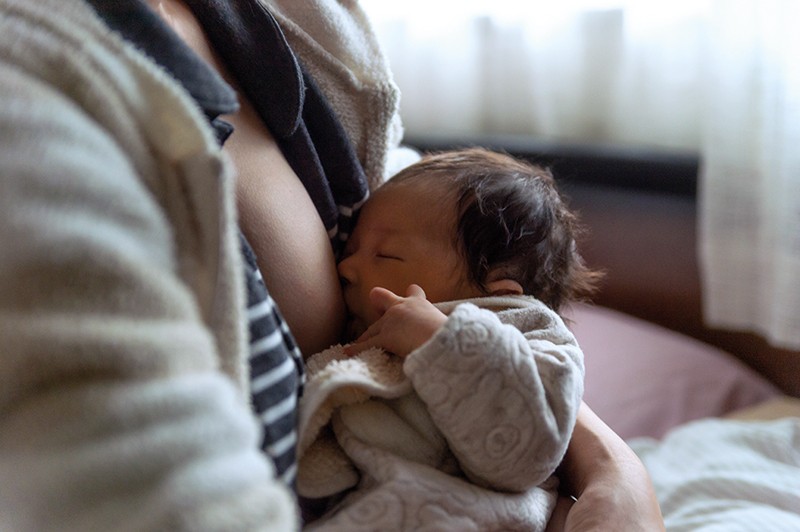From pregnancy, through breastfeeding, to after weaning, our experts explain how your breasts change – plus we give you tips on caring for them along the wayFacebookWhatsAppTwitterPinterestLinkedInShare this content
As soon as you conceive, your body starts preparing for your baby’s arrival. But it’s not just your womb that’s busy – your breast anatomy begins changing radically too. Read on to find out what to expect as you journey through the trimesters, breastfeed your baby, and eventually wean her.
Breast changes in the first trimester
Many women experience breast changes in early pregnancy – in fact, it’s often the first sign you’re pregnant. Surging hormones and a shift in breast structure mean your nipples and breasts may feel sensitive and tender from as early as three or four weeks. Some mums-to-be have sore breasts during pregnancy right up until the birth, but for most it subsides after the first trimester.
“Breast growth in pregnancy may be rapid during the early weeks, or the size may increase gradually,” explains Dr Jacqueline Kent, a leading lactation researcher at the University of Western Australia. “Every woman is different. Your breasts might not actually grow much until shortly before – or even after – the birth. But if you’re wondering how much breasts grow during pregnancy in total, by the time your milk comes in they’re likely to be almost one-and-half times bigger than before you became pregnant!”1
Once your regular bras start feeling tight – usually by 12 weeks or so – it’s time to buy a maternity bra. Most women find a seamless style with wide straps in a soft, breathable fabric most comfortable. It’s best to avoid underwires, as they can dig into your developing milk ducts.
Get yourself measured properly to ensure a good fit. And get remeasured every couple of months throughout your pregnancy, as you’ll go through a few sizes as your baby and breasts grow.
Breast changes in the second trimester
From around your 15th week of pregnancy the new milk-producing cells in your breasts become active, and by around week 22 they start making milk.1 But don’t worry – most of this milk will be reabsorbed by your body, while your pregnancy hormones also prevent much from building up or escaping.
“During the second trimester, you may notice your nipples and areolae (the circles of skin surrounding them) becoming larger and darker,” says breastfeeding research associate at Medela Dr Danielle Prime. “Another way the areola changes is that the little bumps or pimples on it become more noticeable. These wonderfully named ‘Montgomery’s tubercles’ produce a moisturising oil that helps protect against soreness and infection once you start breastfeeding. In fact, scientists believe the smell of this oil is similar to amniotic fluid and may help guide your newborn to your nipples after she’s born.”2
Don’t strip these natural oils from your nipples by using harsh soap or rubbing them dry with a towel. Just use warm water and pat them dry. And if anyone suggests ‘toughening’ your nipples for breastfeeding by pinching or rubbing, ignore them!
If you have flat or inverted nipples, and you’re beyond week 32 of a healthy pregnancy, you could wear nipple formers inside your bra. These can help to gently draw out your nipples, making it easier for your newborn to latch on. Ask a healthcare professional or read our article about inverted or flat nipples for more advice.
If you experience a sudden increase in breast size during pregnancy, your breasts may feel itchy and you might develop stretch marks. A gentle moisturiser can help soothe the itch. However, stretch marks are normally a matter of genetics and skin type; if you’re predisposed to them, there’s not much you can do to prevent them – but the good news is they will fade and become much less noticeable over time.
Breast changes in the third trimester
Your breasts may start to feel heavy or sore again during the last trimester. Wearing a sleep bra in bed might make you more comfortable, and it’s a good idea to wear a supportive sports bra when you exercise to avoid breast pain and ligament damage.
Remember to get a couple of breastfeeding bras the month before your baby is due. If possible, buy from a shop that has a fitter experienced in nursing bras, or consult an online fitting guide. Every woman is different, but your breasts are likely to be around one to two bra cup sizes bigger than before pregnancy. Your band size will probably increase too, as your ribcage expands to make room for your baby. Your fitter should recommend a size that allows room for your milk to come in once your baby is born too. A style with clips that you can undo one-handed can make positioning your baby easier.
Amazingly your milk is ready in your breasts before your baby is born. This means your nipples might start leaking a little colostrum – early breast milk – which is rather thick and sticky. It can happen as early as 14 weeks, but is more common in late pregnancy. You can wear nursing pads inside your bra to stop damp patches showing through.
“If you have pre-existing or gestational diabetes, your healthcare professional may advise you to hand express some colostrum and freeze it. A recent study showed this is safe to do after the 36th week of an otherwise healthy pregnancy,”3 advises Dr Prime. “Having a supply of colostrum to hand can be helpful, because babies of diabetic mothers are at higher risk of experiencing low blood sugar levels (hypoglycaemia), and the best thing to help raise these levels is frequent feeds of colostrum. Don’t expect to be able to express large amounts though – you’ll probably only manage a few drops at a time and that’s perfectly OK.”
What happens to your breasts after birth
Around two to four days after your baby is born (sometimes longer if you’ve had a c-section or traumatic delivery), you’ll feel your breasts becoming much fuller and firmer as your milk comes in.4
“This fullness isn’t only caused by the extra milk you’re starting to produce – the amount of blood circulating around your breasts has also increased and there can be more lymphatic fluid in them too,” explains Dr Prime. “This is all happening in response to the decreasing levels of pregnancy hormones in your body (that have been dropping gradually since you gave birth), which allows your milk-production hormones to get to work.”
Your breasts might become uncomfortable or even painful over this period, a condition called engorgement. This is very common and usually wears off after a few days, during which time you should continue to breastfeed. Take a look at our tips on dealing with the discomfort and swelling, and if the problem persists speak to a lactation consultant or breastfeeding specialist.
What happens to your breasts during lactation
During the first three months or so of breastfeeding, your breasts will probably still feel quite full before a feed. As your baby grows, you may notice they don’t feel as full any more, but this doesn’t mean you’re making less milk. If you’re breastfeeding exclusively and on demand, and your baby is growing well, you should still be making plenty.
“After six months of breastfeeding, expect your breasts to start becoming smaller,” explains Dr Kent. “This is not an indication that you’re producing less milk, but it may be that you’re losing some of the fatty tissue in the breast. By the time your baby is 15 months old, you can expect your breasts to be the same volume they were before conception, but not smaller. This is true whether you’re still breastfeeding or not – you may still be producing 100 to 300 ml (3.5 to 10 fl oz) of milk per day.”
This seems to be because your breasts work more efficiently after six months, which Dr Kent’s study found may be due to a redistribution of breast tissue.5
How your breasts change after weaning
When you eventually stop breastfeeding your baby – whether that’s after three weeks, three months or three years – breast changes due to lactation will reverse. “When you wean completely you can expect your breasts to return to similar to preconception size over the next three months, if they haven’t already,” explains Dr Kent. But if you get pregnant again, the whole process will begin anew.























